“Variance” Would Allow Polluters To Evade Strict Pollution Controls
Would Allow The Discharge Of More Carcinogenic Chemicals Into Public Water Supplies
On July 5, 2022, the Murphy DEP quietly proposed amendments to DEP’s surface water quality standards and water pollution discharge regulations (NJPDES) (no press release on that!).
Among other highly technical but important things, the DEP stealthed proposal of a huge loophole that major polluters have long sought and environmental groups and US EPA strongly opposed.
The DEP proposal would create a “variance” from the requirements to comply with NJ water quality standards and strict pollution discharge permit requirements designed to meet the standards known as “water quality based effluent limits” (WQBELs).
The federal Clean Water Act mandates imposition of strict WQBELs when minimum technology based pollution controls are not adequate to meet water quality standards and the waterbody becomes legally “impaired” (i.e. violates water quality standards and is excessively polluted such that it does not support aquatic life, designated uses, and/or is unsafe to fish or swim in).
Buried in the fine print of the DEP’s complex 84 page proposal, we find a casual allusion to this: (emphasis mine). The DEP proposal states:
The Department is also adding new N.J.A.C. 7:9B-1.16 to establish provisions for the development, adoption, and implementation of water quality standards (WQS) variances. […]
A permittee requesting a WQS variance must justify and demonstrate to the satisfaction of the Department that the SWQS cannot be met due to natural, physical, irretrievable human-caused conditions, or controls more stringent than those required at Sections 301(b) and 306 of the Federal Act, and would result in substantial and widespread economic and social impact, as proposed at N.J.A.C. 7:9B-1.16(b)4.
Keep that phrase “substantial and widespread economic and social impact” in mind.
It is a bureaucratic euphemism for considering the economic costs of industry compliance with strict standards designed to protect public health and the environment.
The “variance” is very broadly defined and can be granted for a single polluter, a group of polluters, or even an entire watershed. The DEP proposal states:
A WQS variance, which satisfied the above requirements, may be proposed to be adopted for a single permittee or multiple permittees. A WQS variance may also be proposed to be adopted for a waterbody segment or an entire watershed.
An example of that would be to allow all industrial and sewer plant discharges on the Delaware River – a drinking water source – to avoid strict permit WQBEL’s for toxic chemicals. The Delaware River is legally “impaired” for multiple toxic pollutants, including mercury and PCBs, and strict discharge permit WQBELs are mandated under the Clean Water Act.
Another example would be to allow all sewage treatment plants on the Passaic River – a drinking water source – to avoid strict discharge permit WQBELs for phosphorus and nitrogen (nutrients) designed to reduce eutrophication of the river and the Wanaque reservoir that is replenished by polluted water pumped from the river.
Similarly, the Passaic River is legally “impaired” for multiple toxic pollutants and nutrients and strict discharge permit WQBELs are mandated under the Clean Water Act.
Stunningly, the DEP proposal provides an example of how the “variance” would be implemented that should shock the conscience. DEP openly admits that they are elevating consideration of polluters’ compliance costs over public health: (using the word “difficult” to mask economic considerations). The DEP proposal states:
For example, the removal of arsenic from municipal wastewater below 2.0 μg/L using conventional technologies, such as coagulation, sedimentation, filtration, and adsorption may be currently difficult to achieve. The Department anticipates that its proposed WQS variance process will facilitate the identification of methods to achieve the maximum removal possible using conventional technologies.
Polluters want to retain “conventional technologies” and avoid costly upgrades in treatment and pollution controls that are legally triggered by WQBELs.
For decades, major industrial polluters and sewage treatment plants have sought the “variance” as an “exit ramp” or “relief valve”, i.e. as a means to avoid compliance with legally mandated and costly DEP imposed permit WQBELs.
For decades, NJ DEP implemented State surface water quality standards and water pollution control programs that were stricter than the minimum federal Clean Water Act program administered by US EPA. Accordingly, DEP refused to provide the “variance” “relief” sought by polluters and refused to amend NJ’s strict water quality standards to allow for a “variance”.
Historically, EPA held the DEP’s feet to the fire in implementing that stricter NJ State water program and effectively blocked polluters from lobbying DEP to roll back NJ’s stricter clean water program.
That strict DEP policy (i.e. NJ DEP standards are stricter than federal US EPA minimums) was reversed during the Whitman Administration.
Gov. Whitman issued Executive Order #27, which sought to roll back NJ DEP standards to federal minimums.
The Whitman DEP’s proposed rollbacks were strongly opposed by environmental groups, exposed by the press, and condemned by a huge public outcry.
That strong opposition derailed the Whitman DEP “mega-rule” rollback.
The next McGreevey DEP also was pressured by politically powerful corporate polluters to provide regulatory relief via a “variance”.
We blew the whistle on that by leaking a letter from the NJ Chemistry Council to the DEP, thanking DEP for abandoning proposed strict water quality standards for mercury and PCB’s (read the smoking gun NJ CIC letter to DEP).
Shortly thereafter, following their victory in eliminating DEP’s proposed strict toxic water quality standards, the Chemistry Council next persuaded DEP to draft a regulatory “variance” proposal” (see below):
Note how DEP attempted to use the same “substantial and widespread economic and social impact” phrase to justify a variance loophole to avoid compliance with toxic PCB water quality standards (plus mercury as well).
We blew the whistle on that too.
We later publicly released another smoking gun DEP staff “Hot Issues” briefing memo to DEP Commissioner Cambell that explained why DEP abandoned proposed strict toxic water quality standards for PCB, mercury and DDT and how DEP would propose a “state-wide variance from water quality standard” to provide relief from struct WQBEL permit requirements (read the whole smoking gun DEP staff “Hot Issues” briefing memo on variance).
We also revealed a secret DEP meeting with the Chemistry Council and a prior DEP meeting and Power-Point presentation by the Chemistry Council.
Look at the major polluters who attended that secret meeting:
They make it very clear that they oppose the cost of compliance with the “enormously expensive” DEP’s proposed toxic standards.
They also explicitly threaten to gridlock the DEP permit program with legal appeals of permits, which is exactly the same tactic they successfully used previously to convince DEP to provide permit relief from the mandatory enforcement penalties of the Clean Water Enforcement Act:
Look (above) at how the chemical industry and their business lobbyist friends explicitly invoke the need for “variance” relief from the strict toxic standards!
This is exactly the regulatory relief the Murphy DEP is now proposing with their “variance” proposal.
The DEP’s meeting notes from that CIC meeting exposed the agenda. DEP wrote that the Chemistry Council:
“needs legal way to protect from end of pipe limits”
The term “End of pipe limits” is shorthand for legally mandated WQBELs.
Let that phrase sink it: “needs legal way to protect from end of pipe limits” – DEP is admitting that they are protecting toxic polluters!
(this is actually worse than the Christie DEP’s proposed weakening of “mixing zone” regulations)
Based on our disclosures and with behind the scenes help from US EPA, the McGreevey DEP draft “variance” proposal was abandoned and never proposed. We killed it in its crib.
So, after many years of successful opposition, it galls me deeply to see the Murphy DEP propose the huge “variance” loophole sought by corporate polluters, and to do so with absolutely no pushback or opposition by NJ environmental groups or media coverage.
The people of NJ should be outraged that their DEP is caving in to the political pressure of corporate polluters and elevating economic considerations above their duty to protect human health and the environment via enforcement of strict science based regulations.

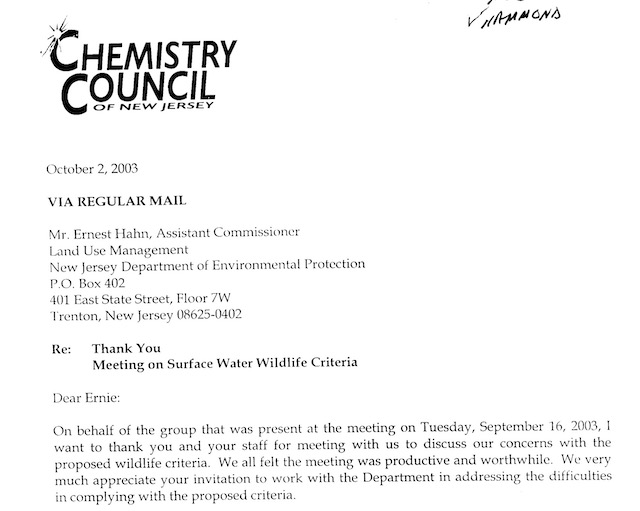
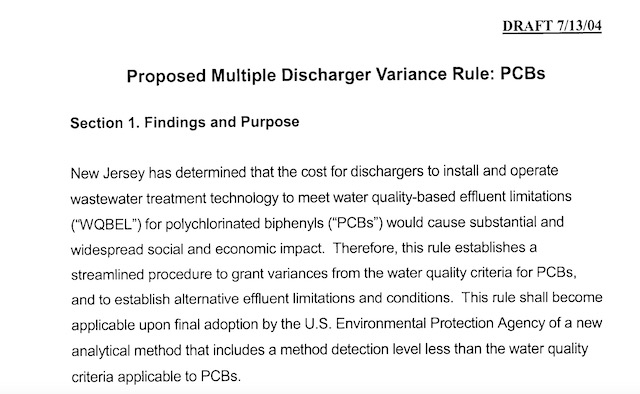
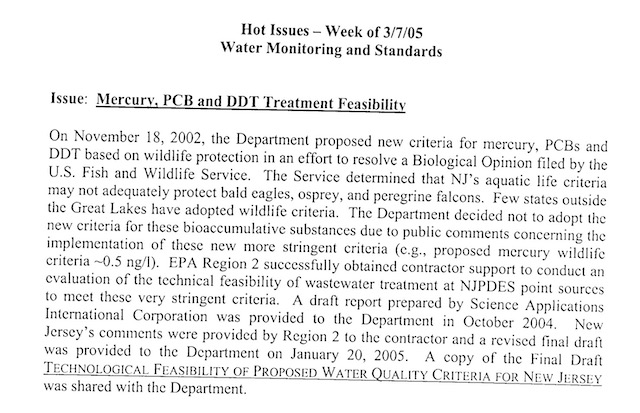
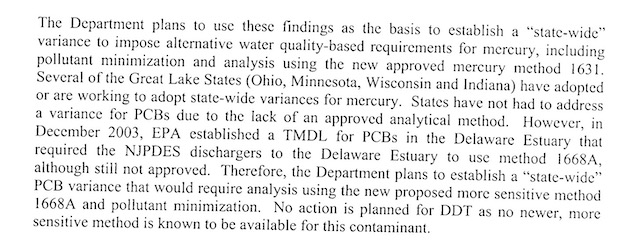
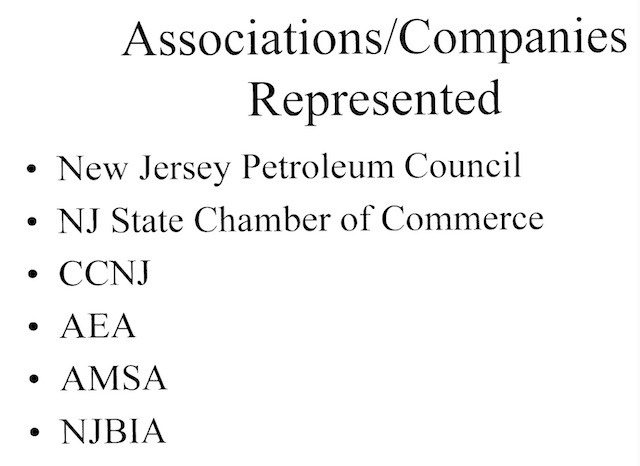

Pingback: WolfeNotes.com » Groundhog Day: Chemical Industry Lobbying Forced NJ DEP To Abandon Proposed Water Quality Standards For PCB’s And Other Toxic Chemicals
Pingback: WolfeNotes.com » On Performative Stunts, Misinformation, Political Cover, And Grifting
Pingback: WolfeNotes.com » Murphy DEP Failed To Update NJ Water Quality Standards To Include US EPA’s Criteria For Toxic Aluminum
Pingback: WolfeNotes.com » As The Clean Water Act Celebrates It’s 50th Birthday, The Murphy DEP Is Using The Same Cost Arguments Richard Nixon Used To Veto The Act
Pingback: WolfeNotes.com » EPA’s Granting Petition To Upgrade Delaware River Water Quality Standards Is Not The Good News It’s Portrayed As
Pingback: WolfeNotes.com » The Murphy DEP Just Inadvertently Admitted That DEP CSO Permits Have No Teeth
Pingback: WolfeNotes.com » Murphy DEP Buys Political Support And Silences Faux Green Critics With Grants
Pingback: WolfeNotes.com » Court Decision Upholding Public Trust Doctrine For Access To Hudson River Walkway Actually Exposes Limitations In Enforcement Of The Doctrine
Pingback: WolfeNotes.com » There Is No Line Of Murphy DEP BS That Jon Hurdle And NJ Spotlight Won’t Print
Pingback: WolfeNotes.com » Why Is NJ Spotlight Tacitly Encouraging Poor And Minority Communities To Eat Toxic Fish?